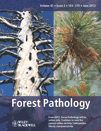
FOREST PATHOLOGY
Scope & Guideline
Innovating Solutions for Sustainable Forestry
Introduction
Aims and Scopes
- Investigation of Fungal Pathogens:
The journal publishes studies that investigate various fungal pathogens affecting forest trees, including their identification, pathogenicity, and ecological impact. - Molecular Techniques in Pathology:
There is a strong emphasis on molecular methodologies, such as qPCR and genetic characterization, to understand pathogen behavior and tree responses to diseases. - Ecological and Environmental Interactions:
Research exploring the interactions between pathogens and their environments, including soil, host species, and climatic factors, is a core focus. - Management and Control Strategies:
The journal addresses practical management strategies for disease control in forestry, including the use of biocontrol agents and integrated disease management approaches. - Emerging Tree Diseases:
Studies on newly identified or emerging diseases affecting trees, particularly those that pose significant threats to forest health, are a consistent area of publication.
Trending and Emerging
- Climate Change Impacts on Forest Pathology:
There is a growing body of work examining how climate change affects tree diseases, including shifts in pathogen distribution and disease severity. - Genetic Resistance and Tree Breeding:
Research focusing on the genetic resistance of tree species to various pathogens is gaining traction, highlighting the importance of breeding programs in forestry. - Integrated Pest and Disease Management:
An increasing number of studies are exploring integrated approaches combining biological control, chemical treatments, and cultural practices for effective disease management. - Phylogenetic Studies of Pathogens:
There is a notable trend towards phylogenetic and molecular studies that provide insights into the evolutionary relationships among tree pathogens, enhancing understanding of their biology and ecology. - Use of Technology in Pathology Research:
Emerging technologies, such as remote sensing and real-time monitoring, are being increasingly applied to assess and manage forest diseases, indicating a shift towards innovative methodologies.
Declining or Waning
- Non-Fungal Pathogens:
Research on bacterial and viral pathogens has been less frequent compared to studies on fungal diseases, indicating a waning interest or perceived importance in these areas. - Historical Pathology Studies:
There seems to be a decrease in studies focusing solely on historical accounts of tree diseases, as the journal shifts towards more contemporary issues and emerging pathogens. - Generalized Disease Surveys:
Publications that present general surveys of diseases without specific case studies or detailed methodologies are becoming less prominent, with a trend towards more focused research.
Similar Journals
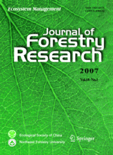
JOURNAL OF FORESTRY RESEARCH
Exploring the depths of ecological innovation.JOURNAL OF FORESTRY RESEARCH, published by Northeast Forestry University in China, stands as a pivotal platform for advancing the field of forestry science. With an ISSN of 1007-662X and an E-ISSN of 1993-0607, this esteemed journal has maintained its commitment to disseminating high-quality research since its inception in 1997, converging into a recognized authority through the years. Currently boasting a Q1 ranking in the Forestry category for 2023, it ranks 18th out of 174 journals in its field on Scopus, highlighting its vital role in shaping contemporary forestry studies. The journal focuses on a broad spectrum of topics pertinent to forestry, including sustainable forest management, ecology, and conservation efforts, making it an indispensable resource for researchers, professionals, and students alike. Although it is not an open-access publication, the insights shared within its pages promise to contribute significantly to the advancement of knowledge and practices in forestry. The journal's significant impact and relevance are underscored by its operations from Harbin, People's Republic of China, where it continues to foster scholarly communication in the world of forestry research.

BALTIC FORESTRY
Elevating Global Discourse on Forest ConservationBALTIC FORESTRY, published by the INST FORESTRY LRCAF in Lithuania, is a prominent academic journal that serves as a platform for disseminating cutting-edge research in the field of forestry. With an ISSN of 1392-1355, this journal is dedicated to advancing knowledge on sustainable forest management, ecological impacts, and resource conservation, among other vital topics. As of 2023, it has been categorized in the Q3 quartile for forestry in Scopus, indicating its solid reputation among peer-reviewed publications, ranking #95 out of 174 in the realm of Agricultural and Biological Sciences. BALTIC FORESTRY features contributions from researchers across the globe and encourages innovative approaches to solving contemporary challenges in forestry, making it an essential resource for professionals, scholars, and students alike. Although it operates under subscription-based access options, the journal's commitment to fostering academic discourse is unwavering, aiming to bridge the gap between theory and practice in forest science.

FORESTRY CHRONICLE
Connecting research and real-world forestry solutions.FORESTRY CHRONICLE, published by the Canadian Institute of Forestry, is a leading journal dedicated to advancing knowledge in the field of forestry and environmental science. With a rich history of dissemination of impactful research since its inception, this journal plays a crucial role in bridging the gap between theory and practice for professionals, researchers, and students alike. Based in Canada, the journal is indexed in Scopus, ranking within the Q3 quartile for the field of Forestry and demonstrating its commitment to quality and relevance in agricultural and biological sciences. While it does not currently offer open access, its circulation extends internationally, ensuring a wide reach for innovative ideas and findings in forest management, conservation, and ecological sustainability. As a vital resource, FORESTRY CHRONICLE continues to foster dialogue and collaboration among stakeholders invested in the sustainable use of forest resources, making it an essential addition to your academic repertoire.
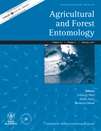
AGRICULTURAL AND FOREST ENTOMOLOGY
Uncovering the secrets of insects for sustainable agriculture.AGRICULTURAL AND FOREST ENTOMOLOGY is a leading journal published by Wiley, focusing on the interface of entomology, agriculture, and forestry. With a robust impact reflected in its Q2 and Q1 quartile rankings in prominent categories like Agronomy and Crop Science, Forestry, and Insect Science, this journal serves as a vital platform for researchers and professionals seeking to advance their understanding of insect impacts on agricultural and forest ecosystems. Since its inception in 1999, it has provided a comprehensive collection of high-quality research, facilitating interdisciplinary discussions and innovations in pest management, biodiversity, and sustainable practices. Although it does not currently offer Open Access, the journal continues to uphold rigorous peer-review standards, ensuring that published works maintain a profound scientific value. As of 2023, its Scopus rankings further signify its prominence in the field, engaging a global audience keen on addressing the pressing challenges faced within agricultural and forest sciences.
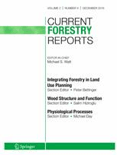
Current Forestry Reports
Advancing sustainable forestry research for a greener tomorrow.Current Forestry Reports, published by Springer International Publishing AG, stands at the forefront of forestry and ecological research, boasting an impressive array of quartile rankings in 2023 such as Q1 in Ecology and Forestry. With an ISSN of 2198-6436, this journal has emerged as a pivotal platform for disseminating innovative research findings and insights critical to the sustainable management of forest ecosystems. Operating out of Switzerland, it covers a broad scope that spans from ecological theory to practical forestry applications and landscape conservation. Notably, it ranks #3 out of 174 in Agricultural and Biological Sciences: Forestry and #4 out of 211 in Environmental Science: Nature and Landscape Conservation, reflecting its high impact and relevance in the field, placing it in the top percentiles in multiple categories. This open-access journal endeavors to provide a comprehensive understanding of contemporary issues, trends, and methodologies in forestry and related disciplines, making it an indispensable resource for researchers, practitioners, and students who are dedicated to advancing knowledge and practices in forest science.
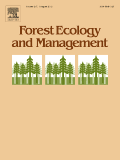
FOREST ECOLOGY AND MANAGEMENT
Transforming Insights into Action for Forest HealthFOREST ECOLOGY AND MANAGEMENT is a premier peer-reviewed journal dedicated to the integral study of forest ecosystems and their management, published by Elsevier in the Netherlands. With an impactful presence in the field, this journal boasts a prestigious Q1 ranking in multiple categories, including Forestry, Management, Monitoring, Policy and Law, and Nature and Landscape Conservation as of 2023. It addresses key issues relevant to sustainable forest practices, conservation strategies, and environmental monitoring, making it a vital resource for researchers, practitioners, and policymakers alike. The journal is indexed with an impressive Scopus rank, placing it among the top tier of titles in Agricultural and Biological Sciences and Environmental Science. While it does not offer Open Access options, its rigorous review process and high visibility make it essential for those seeking to stay abreast of the latest findings and trends in forest ecology and management. Published continuously since 1976, FOREST ECOLOGY AND MANAGEMENT aims to foster interdisciplinary collaboration and advance knowledge critical to the stewardship of forest resources in an ever-changing global landscape.

Central European Forestry Journal
Exploring the depths of Central European forestry science.Central European Forestry Journal, published by SCIENDO, is a pivotal platform dedicated to advancing research and knowledge in the field of forestry. Since its inception in 2009, this Open Access journal has provided scholars and practitioners with unrestricted access to cutting-edge research findings, promoting collaboration and innovation within the forestry community. Based in Poland, the journal serves as a crucial resource for researchers, professionals, and students alike, addressing critical topics relevant to the management, conservation, and sustainable utilization of forest resources. The journal holds a commendable Q2 ranking in Forestry, with a notable rank of 51 out of 174 and a 70th percentile in Scopus's Agricultural and Biological Sciences category. With converged publication from 2017 to 2024, the Central European Forestry Journal represents an essential avenue for disseminating knowledge and fostering dialogue in an increasingly important field.

Acta Silvae et Ligni
Fostering Collaboration in Forestry Research and Wood ApplicationsActa Silvae et Ligni is a prominent open access journal dedicated to the field of forestry and wood science, published by the esteemed GOZDARSKI INST SLOVENIJE. Since its inception in 2013, the journal has been committed to disseminating high-quality research that provides valuable insights into sustainable forest management, wood properties, and environmental interactions. With its ISSN 2335-3112 and E-ISSN 2335-3953, it serves as a vital resource for researchers, professionals, and students alike, fostering academic collaboration and innovation. The journal’s commitment to open access ensures that research is freely available to a global audience, promoting knowledge sharing and driving advancements in the field. While awaiting formal Scopus rankings, Acta Silvae et Ligni is actively working to enhance its impact and reach, making it a crucial platform for those engaged in the study and management of forest resources.

SILVA FENNICA
Connecting Researchers to the Heart of Ecological ModelingSILVA FENNICA, publishing since 1976, is a premier open-access journal dedicated to the advancement of knowledge in the fields of Forestry and Ecological Modeling. Released under the stewardship of the Finnish Society of Forest Science in collaboration with the Natural Resources Institute Finland, this journal serves as a vital resource for researchers, professionals, and students alike, fostering the exchange of innovative ideas and research findings. With an impressive impact factor placed in the Q1 category for Forestry and holding a commendable Q3 position in Ecological Modeling as of 2023, SILVA FENNICA illustrates its significance by ranking 47th in Forestry and 19th in Ecological Modeling according to Scopus metrics, reflecting a robust peer recognition and dissemination of scholarly work. The journal offers open access to all published articles since 1998, ensuring wide visibility and accessibility of research outputs. Located in Finland, SILVA FENNICA invites contributions that address sustainable forestry practices, forest ecology, and ecological modeling with a commitment to promoting scientific discussion and environmental stewardship.
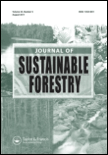
Journal of Sustainable Forestry
Cultivating a sustainable future through research and collaboration.Journal of Sustainable Forestry is a premier academic publication dedicated to advancing knowledge and practices in the field of sustainable forestry and environmental management. Published by Taylor & Francis Inc in the United Kingdom, this journal has been a cornerstone for researchers and professionals since its inception in 1992. With an impressive reputation, it boasts a 2023 Q2 ranking in Food Science, Forestry, and Geography, Planning and Development, highlighting its significant contribution to interrelated disciplines. The journal’s impact is further underscored by its Scopus ranking, especially in Forestry where it holds the 43rd position out of 174 publications, placing it in the 75th percentile. Although not open access, the journal remains committed to providing innovative research and practical insights into forest management, ecological sustainability, and policy development. As the field of sustainable forestry continues to evolve, the Journal of Sustainable Forestry serves as an essential resource for those committed to advancing sustainable practices globally, fostering a deeper understanding of how sustainable forestry can contribute to environmental resilience and biodiversity conservation.